Contributory members are able to log private notes and comments about each site
Sites Anne T has logged. View this log as a table or view the most recent logs from everyone
Hethpool Cairn
Trip No.45 Entry No.7 Date Added: 15th Sep 2017
Site Type: Cairn
Country: England (Northumberland)
Visited: Yes on 12th Sep 2017. My rating: Condition 2 Ambience 4 Access 5
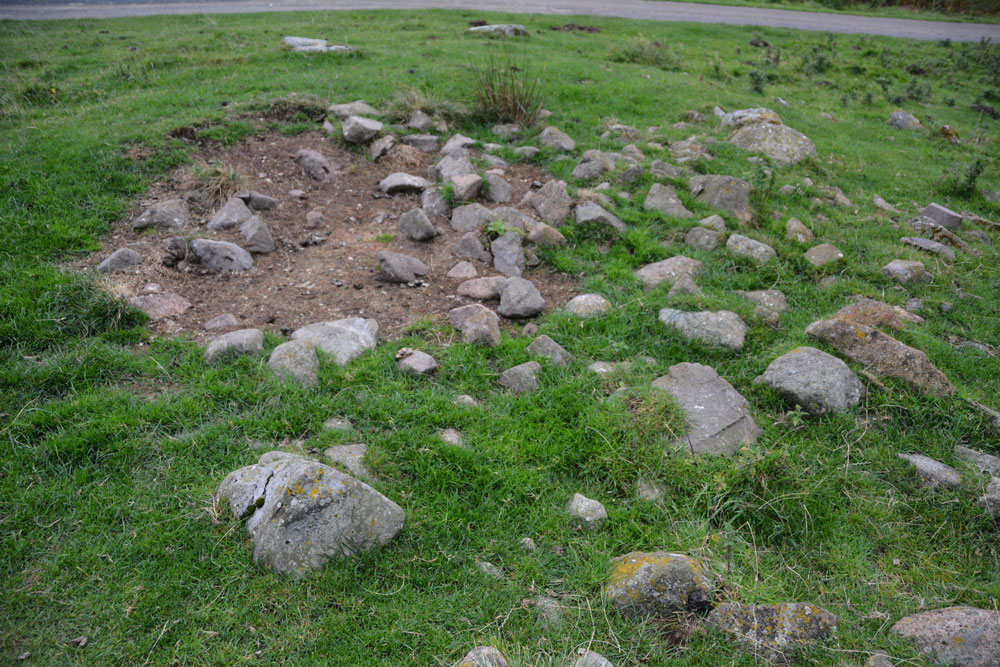
Hethpool Cairn submitted by Anne T on 13th Sep 2017. The Hethpool Cairn, showing its probably robbed centre.
(View photo, vote or add a comment)
Log Text: Hethpool Cairn, College Valley: By this time, it was getting reasonably late in the afternoon, and there was a definite chill in the air. After having been out a lot earlier than our normal setting off time, it seemed way past tea-time. Just as we were approaching Hethpool Stone circles, we both noticed a stony mound to the left hand side of the road, tucked between the road and a narrow band of forest that separates it from the stone circles.
OK, this could be just a dump of stones by the roadside, but I photographed it anyway, enjoying the view south down the valley before we set off for home. Opening up Pastscape later that evening, I was pleased to find this cairn recorded.
Hethpool Stone Circles
Trip No.45 Entry No.1 Date Added: 14th Sep 2017
Site Type: Stone Circle
Country: England (Northumberland)
Visited: Yes on 12th Sep 2017. My rating: Condition 3 Ambience 5 Access 5
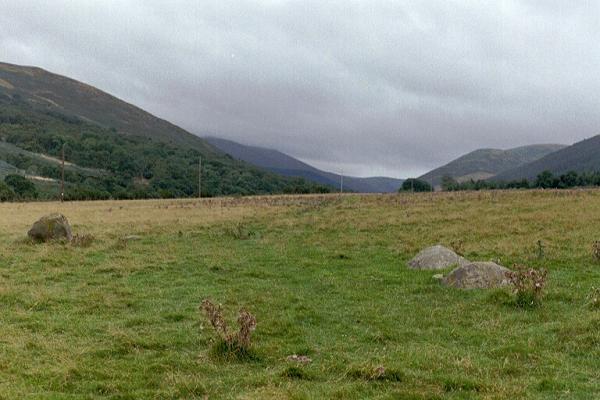
Hethpool Stone Circles submitted by Andy B on 27th Feb 2003. Part of the Burnham family trip to Northumberland, August 2002
(View photo, vote or add a comment)
Log Text: Hethpool Stone Circles, College Valley: We needed to be up really early this morning, but completed what we needed to do by 9am. As there were high winds and rain forecast for this evening/tonight and for the next few days, husband suggested we make the most of the good weather and go up to College Valley. He organised a pass from Saville’s in Wooler (we were one of 8 cars today – usually there are only 1 or 2 the receptionist said).
The last time we were here was over 15 years ago, in the days when I didn’t have a camera, and whilst we saw the stone circle and Little Heatha Fort, didn’t have any evidence of our trip.
Considering this is marked on the map as a (singular) stone circle, it immediately looked (to me) as if there two side-by-side circles – the stones weren’t in one simple circle and they were too widespread. We climbed up to the telegraph pole up the hill to try and get a better look at the circle, but it was still too spread out (and many of the stones too low to the ground) to photograph well.
Given that the small car park at the entrance to the valley was pretty full, and we saw long crocodiles of walkers, we seemed to be the only people interested in the stone circle, which was surprising.
Southernknowe (College Valley)
Trip No.45 Entry No.2 Date Added: 14th Sep 2017
Site Type: Ancient Village or Settlement
Country: England (Northumberland)
Visited: Yes on 12th Sep 2017. My rating: Condition 2 Ambience 4 Access 5
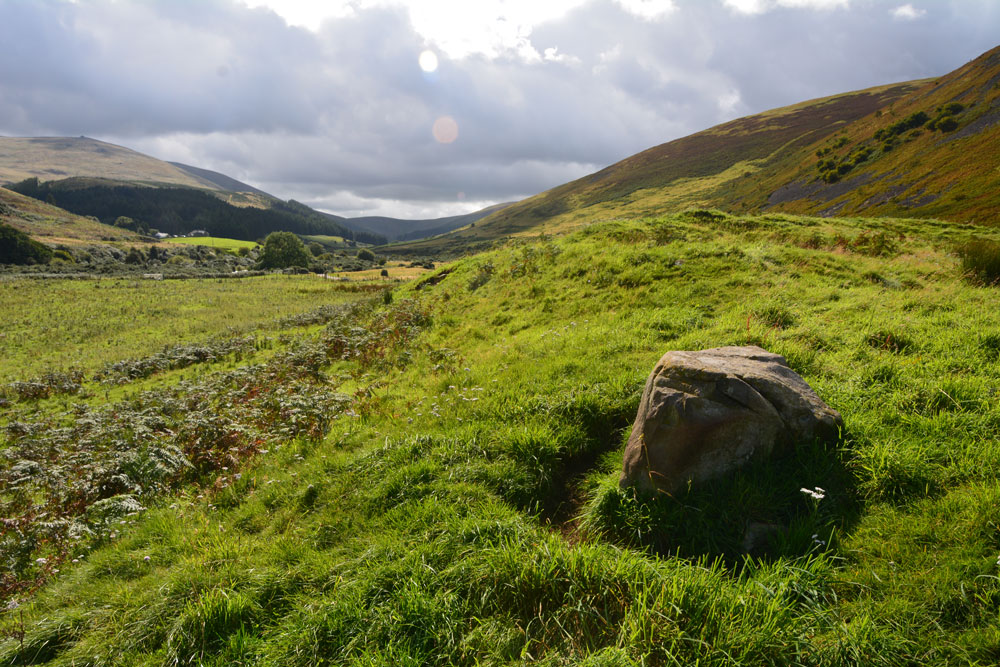
Southernknowe (College Valley) submitted by Anne T on 14th Sep 2017. Standing along the south eastern bank of the settlement, with College Burn to the right hand side in the dip. This large boulder rises up out of the bank. Beyond it, just down the slope, erosion has exposed boulder clay. At this point, the bank is steepest and looks like the settlement has been built on an old river terrace.
(View photo, vote or add a comment)
Log Text: Southernknowe RB Settlement, College Valley: Never having been down so far south in College Valley before, I was fascinated by how beautiful the scenery was, and how many people live here. We saw the sign posts for ‘Wedding This Way’ from Hethpool onwards, and came to the tiny, very white Cuddystone Hall, tucked just behind a small wooded area. Parking on the grassy area with a couple of other cars just north of the hall, we took up the invitation on the College Valley History web page to explore the earthwork remains of the settlement ‘dating from the Roman Iron Age times.’
Just before the road junction and the Airmen’s Memorial (Cheviot Memorial) there is a gate into the field. Letting ourselves in, we wandered round and through this scooped settlement nestled on the west bank of the College Burn, with its scooped hut circles and courtyards. The hut circles were more obvious in the northern (smaller) courtyard. The bank to the south eastern side was steep, dropping down to College Burn. Just past a large boulder on the south eastern bank, erosion left boulder clay clearly visible.
On the hillside to the south west there is another enclosure marked on the OS map, higher up the slopes of Blackhaggs Rigg. We planned to call back here later in the day.
Coldburn (College Valley)
Trip No.45 Entry No.3 Date Added: 14th Sep 2017
Site Type: Ancient Village or Settlement
Country: England (Northumberland)
Visited: Yes on 12th Sep 2017. My rating: Condition 2 Ambience 4 Access 4

Coldburn (College Valley) submitted by Anne T on 14th Sep 2017. Having clambered up the steep(ish) hillside until the land levelled off, this is our first glimpse of the Coldburn Settlement from the north west.
(View photo, vote or add a comment)
Log Text: Coldburn Settlement (College Valley): After visiting the Southernknowe Settlement, the road splits into two. We took the eastern road at this point, travelling over Sutherland Bridge. There is a sign which says to beware as the road is not in very good condition, which is right! It is very narrow and has great potholes in parts.
We managed to pull off the road where a small layby had been created with lots of broken tarmac and stones. From this point, to the west of the settlement, we clambered up the somewhat steep-ish hillside, to where the land levelled off. Heading east, the scoop of the settlement came into view.
There are no obvious internal features within this settlement, but there are certainly views in three directions, with the steep slope of Coldburn Hill on the fourth.
The scoop is deepest to the north of the oval, and there appears to be two terraces cut into the hillside above.
Once in the settlement, we discovered a track cut into the bank of the settlement leading down to Coldburn Farm, so there was a much easier way of accessing this site!
Dunsdale (College Valley)
Trip No.45 Entry No.4 Date Added: 14th Sep 2017
Site Type: Ancient Village or Settlement
Country: England (Northumberland)
Visited: Yes on 12th Sep 2017. My rating: Condition 1 Ambience 4 Access 5
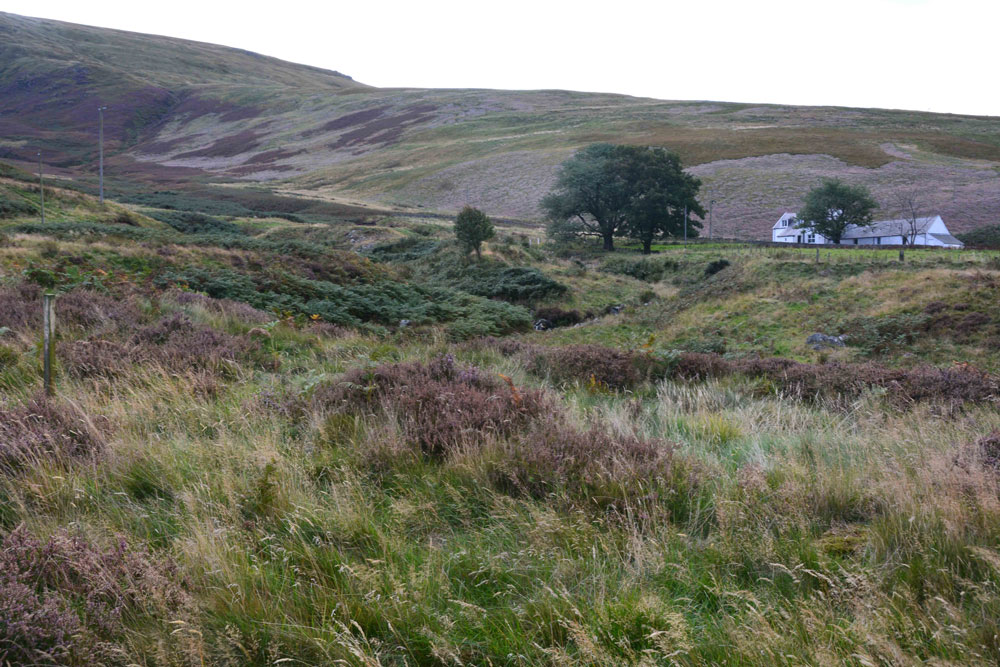
Dunsdale (College Valley) submitted by Anne T on 14th Sep 2017. Standing in the middle of the settlement (largely buried underneath bracken) looking over Bizzle Burn towards Dunsdale Farm
(View photo, vote or add a comment)
Log Text: Dunsdale Settlement, College Valley: Wow. The screen slopes to the north of this path are daunting and impressive at the same time. If there was a landslip here, you might be cut off for some time.
The settlement here was difficult to make out because of the very tall grass and heather, but we could feel stone foundations under our feet and depressions in the ground.
It is a very beautiful spot, with the scree slopes of Dunsdale Crag to the north and Bizzle Burn running to the west of this site.
Would really like to come back here in winter to see more of the site structure.
Mounthooly (College Valley)
Trip No.45 Entry No.6 Date Added: 15th Sep 2017
Site Type: Ancient Village or Settlement
Country: England (Northumberland)
Visited: Yes on 12th Sep 2017. My rating: Condition 2 Ambience 4 Access 4

Mounthooly (College Valley) submitted by Anne T on 15th Sep 2017. First view of the Mounthooly Romano-British Enclosed Scooped Settlement from the sheep pens by the footpath.
(View photo, vote or add a comment)
Log Text: Mounthooly Enclosed Scooped Settlement, College Valley: We drove down the road as far as we could go, nearly at Mounthooly Farm and International Hostelry, and there was a big sign saying ‘no cars past this point’. There were two other cars parked on the grass verge, but no signs of other people.
The road had been gated at Fleehope farm, where they were taking out the whole of the forest by Fleehope Burn, to the west of the farmhouse, and there were huge piles of logs and heavy machinery. Whoever had parked the Land Rover on about a 45 degree slope near the forest had to be congratulated for an epic display of 4 wheel driving!
We walked along the track past Mounthooly Farm and the Hostelry (which has a clean toilet block!), past the narrow strip of forest and found the footpath making its way through the sheep pens, through the field, by a hide. Immediately after coming through the sheep folds, the scoop of the settlement came into view.
Standing towards the western end of the settlement, the scoop is cut deep into the hillside and it seemed to loom around 5+ metres above me, although both Pastscape and Historic England say it’s only 3 metres.
The farmer has been using this area as a dump, and there were no end of empty plastic feed supplement bags and bottles.
There was a clear, wide ditch to the west and south of the settlement; it’s northern end had been cut by the forestry plantation and fence.
My eye was drawn across to the eastern side of College Burn, and a large light coloured boulder. When we got home, it turned out that there was another larger settlement, field systems and cairnfields to the east of the burn. There was also another settlement to the south east of the field, but there was a very large herd of bullocks gathered, so we opted out on this occasion.
What a fascinating area. Needs much more investigation.
Southernknowe Farmstead (College Valley)
Trip No.45 Entry No.5 Date Added: 15th Sep 2017
Site Type: Ancient Village or Settlement
Country: England (Northumberland)
Visited: Yes on 12th Sep 2017. My rating: Condition 2 Ambience 3 Access 4
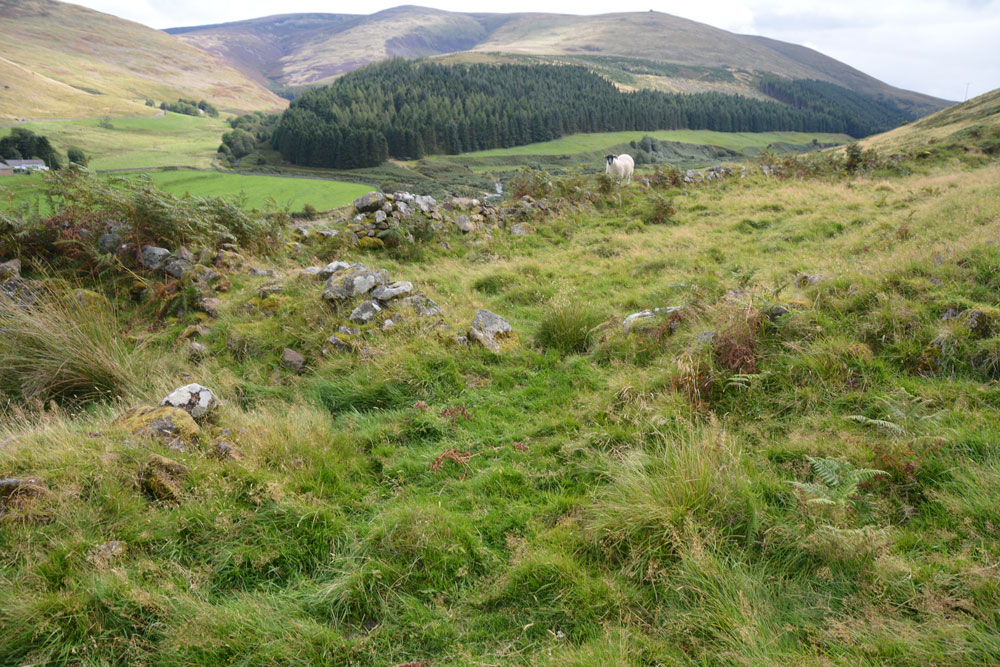
Southernknowe Farmstead (College Valley) submitted by Anne T on 15th Sep 2017. Standing almost at the sheepfold at the northern end of the farmstead, looking back down to College Burn (near where it meets Lambden Burn).
(View photo, vote or add a comment)
Log Text: Southernknowe Enclosed Farmstead, College Valley: This settlement sits high up the eastern slopes of Blackhaggs Riggs, almost opposite where Lambden Burn meets College Burn. Whilst we could see the stone walls/banks of this settlement from below, it was quite a hike up the steep slopes of the hill. Long and narrow, the inhabitants would have had a great view of any other people coming for miles. It is also very scenic, overlooking the meeting of Lambden Burn and College Burn. The river terraces in the valley below can be seen and it’s intriguing how the rivers have moved over the years.
Tullie House Museum
Trip No.46 Entry No.1 Date Added: 19th Sep 2017
Site Type: Museum
Country: England (Cumbria)
Visited: Yes on 18th Sep 2017. My rating: Condition 4 Ambience 2 Access 4
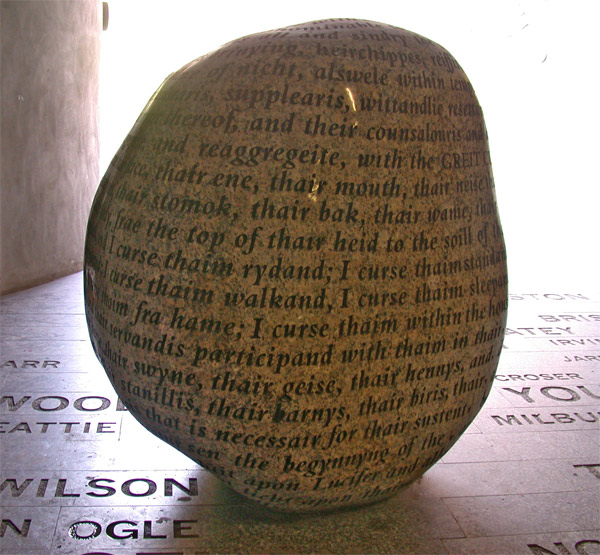
Tullie House Museum submitted by nicoladidsbury on 13th Mar 2005. Cursing Stone, Tullie House Millenium Walkway, Carlisle
The polished granite stone is inscribed with the curse, which was cast on all the reivers of the English/Scottish borders in the 16th Centuary.
The names of those reivers are inscribed in the stones that make up the floor of the millenium walkway, Armstrongs, Grahams, Robsons, Elliotts, and Kerrs to made a few.
The Tullie House Museum has a 10-minute wide-screen audio-visual spectacular which gives a dramatic impression of the lawles...
(View photo, vote or add a comment)
Log Text: The Cursing Stone, Carlisle: This stone is located in the strangely lit underpath that runs the dual carriageway near Tullie House Museum and Carlisle Castle, next to Tullie House museum. We came across this quite by chance, thinking it was located inside the museum. It is actually on the Tullie House side of the pedestrian underpass from the Castle to the Museum.
There is nothing on the walls of the underpass to tell you what this stone is. I’d read about it on the Portal some time ago and recognised it. The wording of the curse is recorded below.
Moor Head (Brundean Laws)
Trip No.47 Entry No.1 Date Added: 3rd Oct 2017
Site Type: Standing Stones
Country: Scotland (Scottish Borders)
Visited: Yes on 20th Sep 2017. My rating: Condition 2 Ambience 3 Access 4
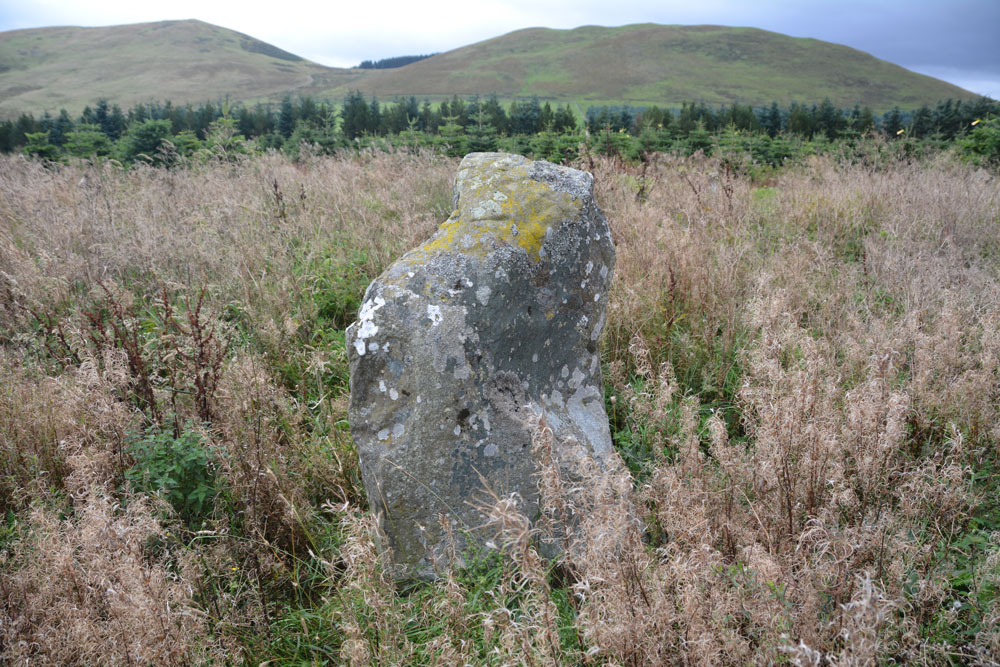
Moor Head (Brundean Laws) submitted by Anne T on 3rd Oct 2017. Looking east across the top of the taller stone, showing it's irregular shaped top.
(View photo, vote or add a comment)
Log Text: Moor Head (Brundean Laws), Scottish Border: This was our first stop on our journey to Armadale, and a part of the world we’ve been to before on a walk up Dere Street, but not stopped at these stones before. We parked at Brundean Laws farm entrance at NT 71651 11987 and walked up the track past the first few houses, to where the track divides at NT 72183 11509 just before Brundean Laws Farm, taking the right hand fork as we faced the main farmhouse. The area where the standing stones are has not been mowed, so stands out as a taller circle of grass around a telegraph pole at the south eastern end of the large field in which the stones stand.
We followed the track that heads of westwards until we were level with the stones, then headed the 30 metres or so to unmown area in which they stood. There is one main stone which is clearly a standing stone, with a second recumbent stone to its south east. A second, broken, stone pokes up out of a mound of smaller stones, which I thought was a quarried stone which had just been dumped, but checking with the Canmore record, this is the second standing stone. With the tall grass and thistles around the stones, it was difficult to tell if there were any more stones undergoot.
The stones do stand on a slight mound (although Canmore says they are 170 metres SSW of Moor Head summit) and if the Christmas tree forest hadn’t been to it’s north, west and south, would have had a commanding view over the surrounding hills which towered above this spot.
Haughhead Kip (Eckford)
Trip No.47 Entry No.2 Date Added: 3rd Oct 2017
Site Type: Sculptured Stone
Country: Scotland (Scottish Borders)
Visited: Yes on 20th Sep 2017. My rating: Condition 3 Ambience 4 Access 4
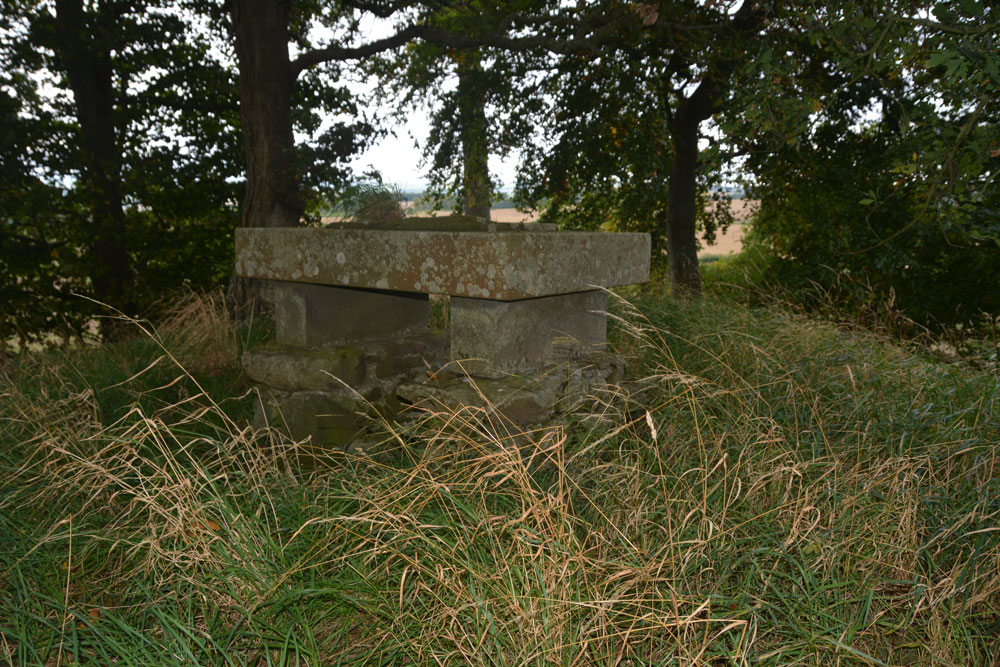
Haughhead Kip (Eckford) submitted by Anne T on 3rd Oct 2017. First view of the 'altar' with the inscribed stone on top, sited on top of the mound/tumulus.
(View photo, vote or add a comment)
Log Text: Haughhead Kip Tumulus & Inscribed Stone, Scottish Borders: This is one of the strangest sites I’ve been to recently, although in a lovely location. Sited just to the east of the A698, north of the B6401 and south of Kale Water, to the north west of the little village of Eckford, we parked on a corner of this narrow road at NT 72558 26695, where there was just enough room to pull the car right off the road. The B6401 was a busy little road, and we avoided cars walking west back to the field with the tumulus.
There is a gate into the field at NT 72289 26736, and it wasn’t until we were 20-30 metres into the field that we realised it had been planted with really tiny cabbage or turnip plants, drilled into wide rows. Being so close to the tumulus, we carefully picked our way across the rest of the field until we got to the gate to the tumulus at about NT 72184 26830. From there, it was a little climb up to what I can only describe as either an altar or a tumbledown box grave.
Certainly worth stopping to see. Canmore debates whether or not the mound was erected to contain the altar. Due to it’s location close to Kale Water, I think it was a tumulus used to locate the inscribed stone on top of it, to give it greater importance.
Ancrum Old Church
Trip No.47 Entry No.3 Date Added: 3rd Oct 2017
Site Type: Sculptured Stone
Country: Scotland (Scottish Borders)
Visited: Yes on 20th Sep 2017. My rating: Condition 3 Ambience 5 Access 4
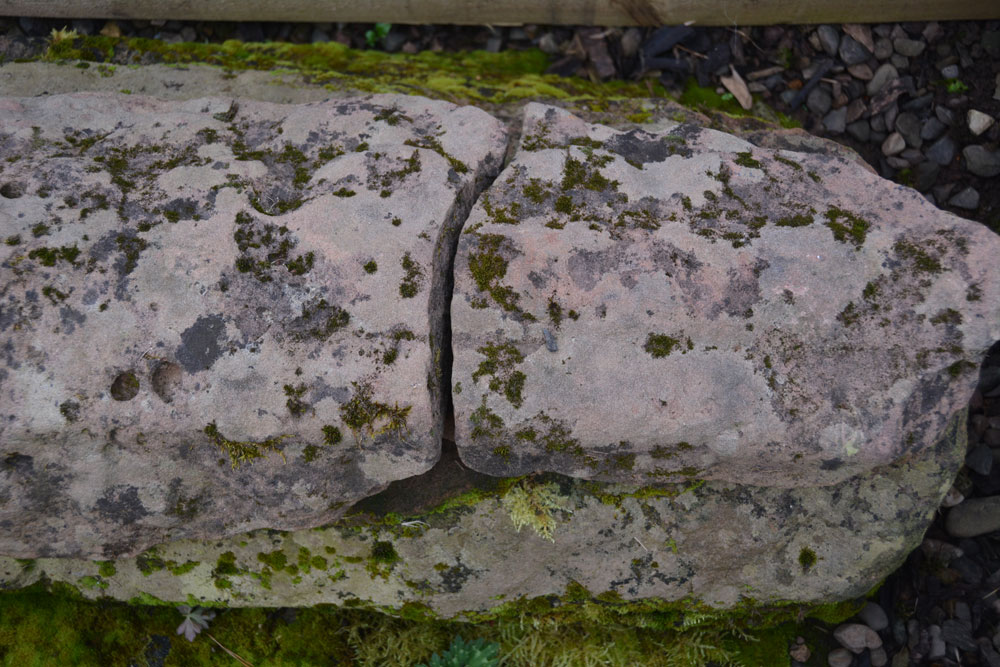
Ancrum Old Church submitted by Anne T on 3rd Oct 2017. A close up of the end of the hogback, trying to see if the camera would pick up any of the relief carving still left on the stone - sadly, no.
(View photo, vote or add a comment)
Log Text: Ancrum Old Church, Scottish Borders: This is a very beautiful location, just to the west of Ale Water and north of the B6400, west of the village of Ancrum. There is parking for 3-4 cars at the south western end of the church yard. A gate and steps lead down into the church yard; the ruined church stands at the northern end of the graveyard.
We walked all around the church, at first unsure of where to look. In the end, by holding my mobile above my head, I managed to get the Canmore record up, so we knew exactly where to look.
Ancrum 1 and 2 are within the village, within private grounds. We did spot the two inscribed slabs, a hogback and a cross base. There was a young man flying a drone all around the church and churchyard, and his dog kept following us. I tried to engage him in conversation, but only got that he was making a film for ‘his own purposes’.
We wandered over the old pack horse bridge to the eastern side of Ale Water, but this was a building site. We could see the western end of Castle Hill hillfort. By this time, it was getting late and the climb looked steep, so we bottled out of the climb, stopping off to look at Ancrum Market Cross on the way to Armadale.
Castle Hill (Ancrum)
Trip No.47 Entry No.4 Date Added: 4th Oct 2017
Site Type: Hillfort
Country: Scotland (Scottish Borders)
Visited: Saw from a distance on 20th Sep 2017. My rating: Condition 2 Ambience 4 Access 4
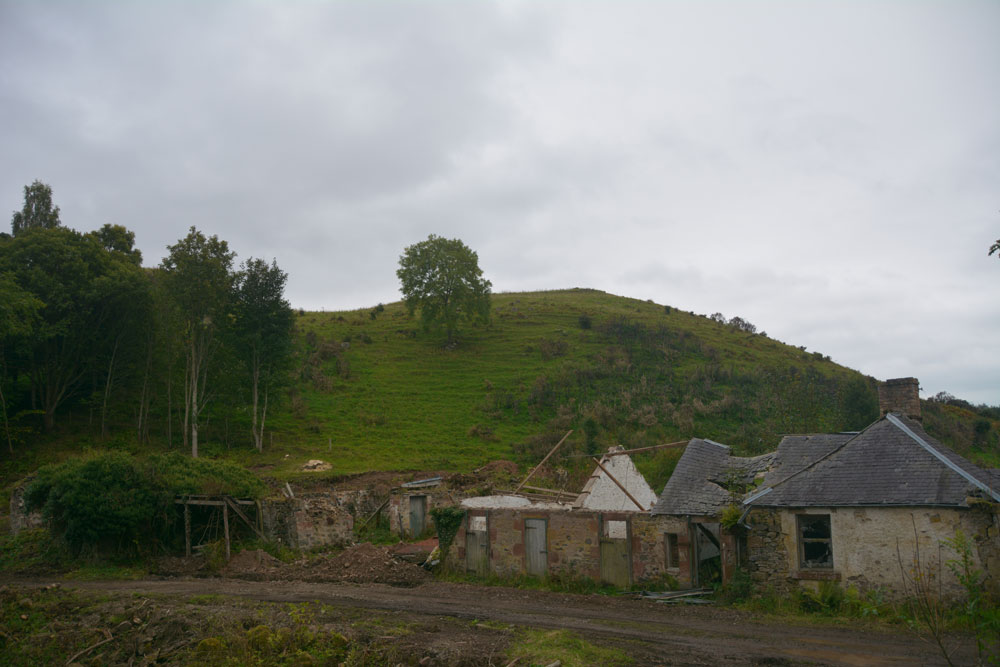
Castle Hill (Ancrum) submitted by Anne T on 4th Oct 2017. Walking through the gate at the eastern side of the ruins, and walking over the old pack horse bridge, the western side of the hillfort can be seen. We were unable to get any further along this path as it was closed due to building works. There is another route to the eastern side of the fort from Ancrum village.
(View photo, vote or add a comment)
Log Text: Castle Hill Hillfort, Ancrum, Scottish Borders: It was getting late in the evening, with dusk coming on, so sadly there wasn’t time to drive back into Ancrum and back round the other side to clamber up to this enticing hill fort, which is visible from Ancrum Old Church and can also be clearly seen on UK Grid Reference Finder. We did try walking across the pack horse bridge across Ale Water, letting ourselves out of the wrought iron gates at the eastern side, but the cottage and adjacent barns we’d have needed to walk through were a building site and were cordoned off.
Decided to leave this for another day, and drove back past the market cross to photograph that before heading off to Armadale.
Balliemore (Craigendive)
Trip No.48 Entry No.1 Date Added: 4th Oct 2017
Site Type: Standing Stones
Country: Scotland (Cowal)
Visited: Yes on 21st Sep 2017. My rating: Condition 3 Ambience 4 Access 4
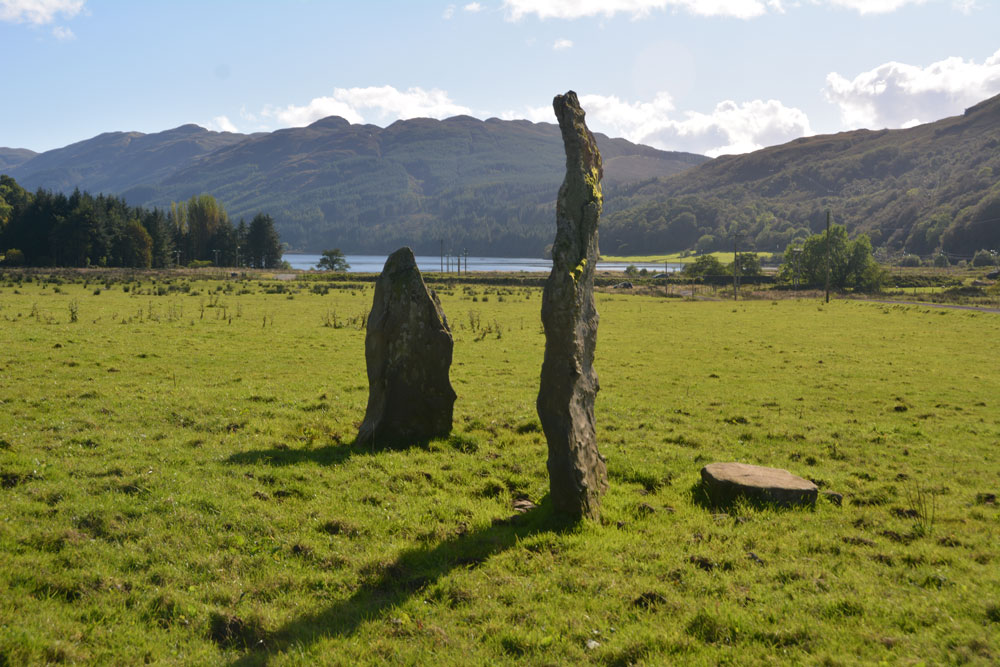
Balliemore (Craigendive) submitted by Anne T on 4th Oct 2017. Standing to the north of these two stones, looking south to the head of Loch Striven. A glorious location.
(View photo, vote or add a comment)
Log Text: Ballimore Standing Stones, West of Dunoon: To escape the rain in Armadale, we decided to take the ferry from Gourock to Dunoon. We stopped off in Dunoon for a cup of tea and a sandwich at The Tudor Coffee Shop above Thornton’s on the main high street, then we set off into the countryside, taking the B836 to Craigendive, past Loch Tarsan.
I spotted these on the map and as they were not very far off the beaten track, decided to stop off and find them. These two stones were in one of the loveliest places, just off the B836 (essentially a single-track road with passing places), to the north of Loch Striven. Surrounded by hills on three sides, on a lush, level grassy plain, with Loch Striven to the south, these standing stones lie immediately south of Balliemore Farm. We parked at NS 05511 84269, next to a pile of road gravel and stones, and walked up the track towards the farm.
There is one tall, narrow stone, and a shorter, triangular one, with a third slab lying at the base of the taller one. Packing stones can be seen in the grass.
The field was very, very wet, and we had to jump over the pools of water at the edge, particularly around the telegraph poles. A pair of wellies would have come in extremely handy!
Glendaruel Churchyard
Trip No.48 Entry No.2 Date Added: 4th Oct 2017
Site Type: Sculptured Stone
Country: Scotland (Cowal)
Visited: Yes on 21st Sep 2017. My rating: Condition 3 Ambience 4 Access 4
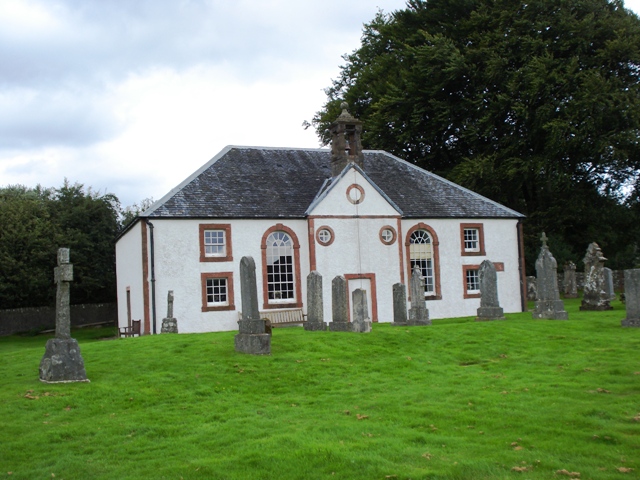
Glendaruel Churchyard submitted by Ghriogair on 21st Jul 2009. Glendaruel Church
(View photo, vote or add a comment)
Log Text: Kilmodan Stones, Glenaruel: Also known as Clacahn of Glendaruel and the Kilmodan Stones
Our second visit of the day, and another lovely spot by the River Ruel. We parked by the now deserted (almost derelict) hotel in Kilmodan village, and walked down towards the church, which is Georgian and very Church of Scotland inside.
The Lapidarium is situated to the south west of the churchyard, nearer to the river. The church guide leaflet says that the Lapidarium was formerly the mausoleum of the Campbells of Auchenbreck, roofed in as a Lapidarium. In 1970, the stones were moved from the graveyard into this building.
“The stones are 14th and 15th century and are of the Loch Awe school of carvers. The stone is schistose and the quality of the stone suggests if would have come from local quarries. In comparison to the other West Highland schools the workmanship is clumsy. In addition, the Loch Awe slabs were never inscribed. So we do not know the names of the patrons commemorated. There are 11 stones in the Lapidarium with number 6 being renowned as the finest example of the Loch Awe School. Stone 11 is the grave slab of Donald McCloy who was minister in Kilmodan from 1609 to 1636.
The bright light streaming into the Lapidarium made at this time of the afternoon made it difficult to photograph the stones properly, despite Andrew trying to block the light out, and me kneeling on the floor to avoid the direct sunlight.
There is a cup and ring marked rock mentioned on the map near to the hotel, although we were unable to find it.
Ardachearanbeg Standing Stone
Trip No.48 Entry No.3 Date Added: 5th Oct 2017
Site Type: Standing Stone (Menhir)
Country: Scotland (Cowal)
Visited: Yes on 21st Sep 2017. My rating: Condition -1 Ambience 4 Access 4
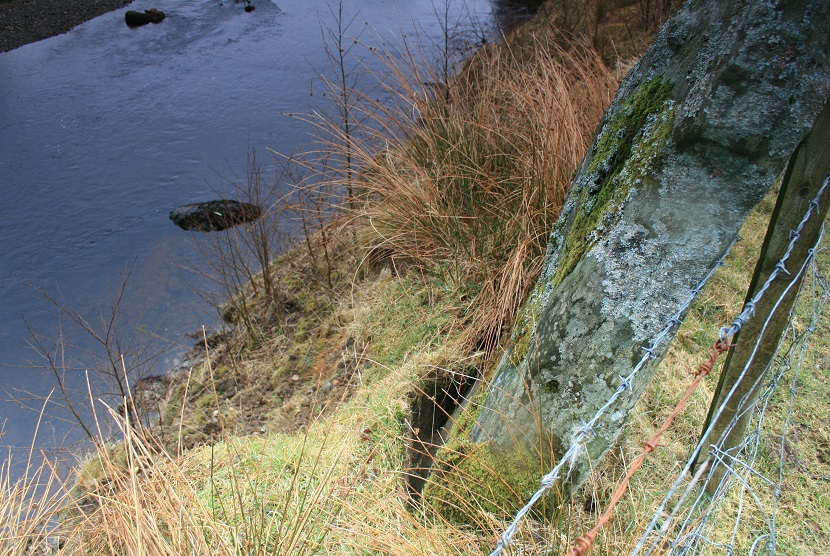
Ardachearanbeg Standing Stone submitted by postman on 7th May 2013. This was three years ago, I wouldn't take the bet its still there.
(View photo, vote or add a comment)
Log Text: Ardachearanbeg Standing Stone, Argyll: Hunted all along the fence line, peering into the river and along the banks for around 100 metres each side of the grid reference and couldn’t find this stone. There was no phone signal, so wasn’t able to call up the Canmore record to double check. Later found out (see below) it has fallen into the river, although we had a pretty good check, looking through the trees and in the river itself, for about 100 metres each way from the grid reference. The river was higher than normal due to all the rain in this part of the world.
Access into the field was from a gate along a small lane just west of the A886 leading to two farms/holiday cottages. There is a small layby at NS 00298 86038 at the junction to these lanes. The field slopes down to the River Ruel. Wellies are advised, as the field was pretty boggy at the time of our visit.
Barmore Fort
Trip No.48 Entry No.5 Date Added: 5th Oct 2017
Site Type: Hillfort
Country: Scotland (Cowal)
Visited: Saw from a distance on 21st Sep 2017. My rating: Condition 3 Ambience 4 Access 4
Barmore Fort submitted by SolarMegalith on 28th Aug 2017. The northern wall of the Barmore fort (photo taken on August 2017).
(View photo, vote or add a comment)
Log Text: Barmore Hillfort, Ormidale, Argyll: We saw this hillfort from a distance only. The map indicated a footbridge across the River Ruel. We drove up and down several times but couldn’t find it. The ground was so wet after heavy rain, we would have needed wellies to navigate the fields, so elected to view this from a distance only. We did drive back along the A886 looking for a parking space on the south eastern side of the fort, but there were only private driveways. A disappointing end to the day.
Galabraes
Trip No.49 Entry No.1 Date Added: 5th Oct 2017
Site Type: Standing Stone (Menhir)
Country: Scotland (West Lothian)
Visited: Yes on 22nd Sep 2017. My rating: Condition 3 Ambience 4 Access 4
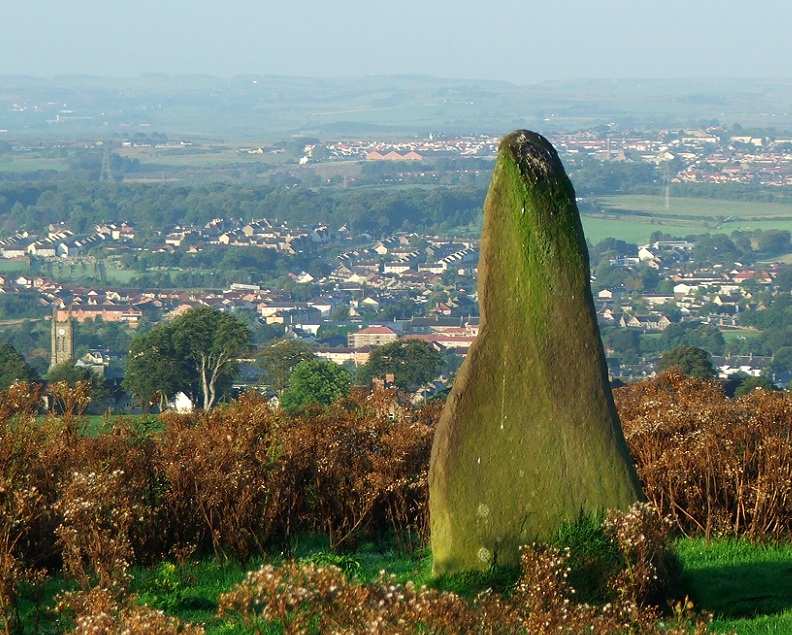
Galabraes submitted by postman on 11th Nov 2012. Site in West Lothian Scotland
Galabraes standing stone, it's not far from Cairnpapple and very close to the road, how com no-ones posted on here before
(View photo, vote or add a comment)
Log Text: Gala Braes Standing Stones, Bathgate: We drove up and down the road, but couldn’t see a gate into the field along either from the ‘main’ road (Drumcross Road) or the side road running north-south up to Cairnpapple Hill, so we ended up clambering over an almost demolished stone wall and squeezing through the wire fencing. There was a big (very unfriendly looking) bull in the field just below the western end of the ridge, who stood his ground and kept looking at us, so we didn’t dare approach the other small knoll where the other stone (B) should have been located.
As we were leaving, I spotted some old boundary features to the south of the standing stone so was photographing these, when I heard some cawing behind me. Looking up, a large crow was sitting on the standing stone, bobbing up and down. Eerie!
Lower Craigmailing (Torphichen)
Trip No.49 Entry No.2 Date Added: 5th Oct 2017
Site Type: Ancient Cross
Country: Scotland (West Lothian)
Visited: Yes on 22nd Sep 2017. My rating: Condition 2 Ambience 1 Access 5
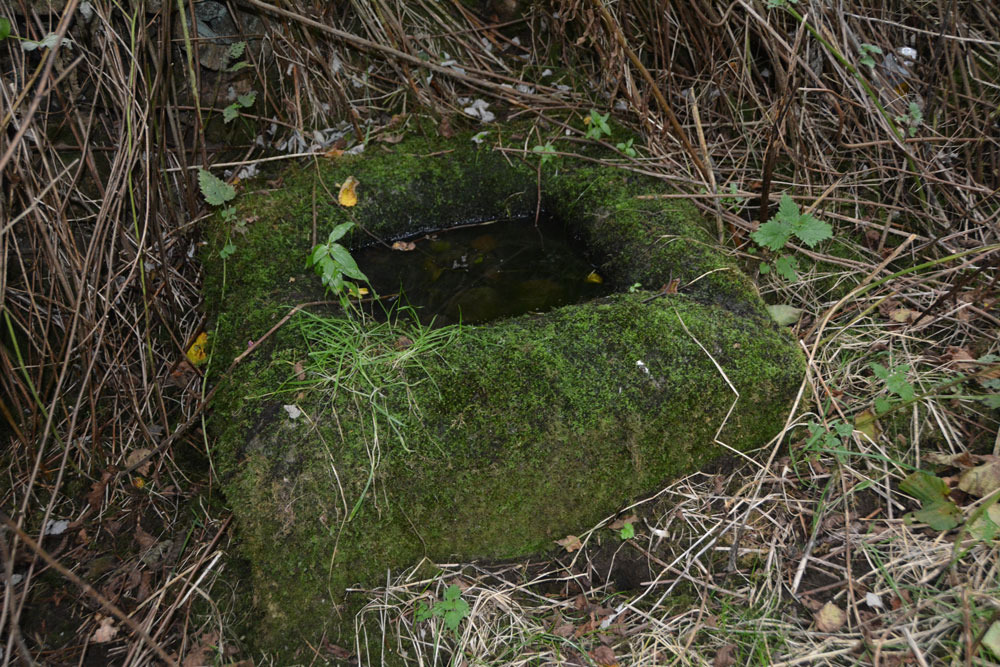
Lower Craigmailing (Torphichen) submitted by Anne T on 5th Oct 2017. In the bottom right hand corner, the shallow channel formed into the corner can be seen, suggesting it might have been used as a trough at some point in its past.
(View photo, vote or add a comment)
Log Text: Lower Craigmailing Socketed Stone: This socketed stone was well hidden under shrubbery at the start of a footpath running from Cathlaw Lane to Witch Craig/Crag. I would have walked right by it, had husband, Andrew, not pushed his way through the shrubbery to find it.
What a sad fate for this socketed stone. Being located so close to Torphichen, I assume it had something to do with marking the way to/from the Abbey, possibly up to Cairnpapple Hill.
Cockleroy Hill (Beecraigs)
Trip No.49 Entry No.3 Date Added: 22nd May 2019
Site Type: Hillfort
Country: Scotland (West Lothian)
Visited: Yes on 22nd Sep 2017. My rating: Condition 2 Ambience 3 Access 4
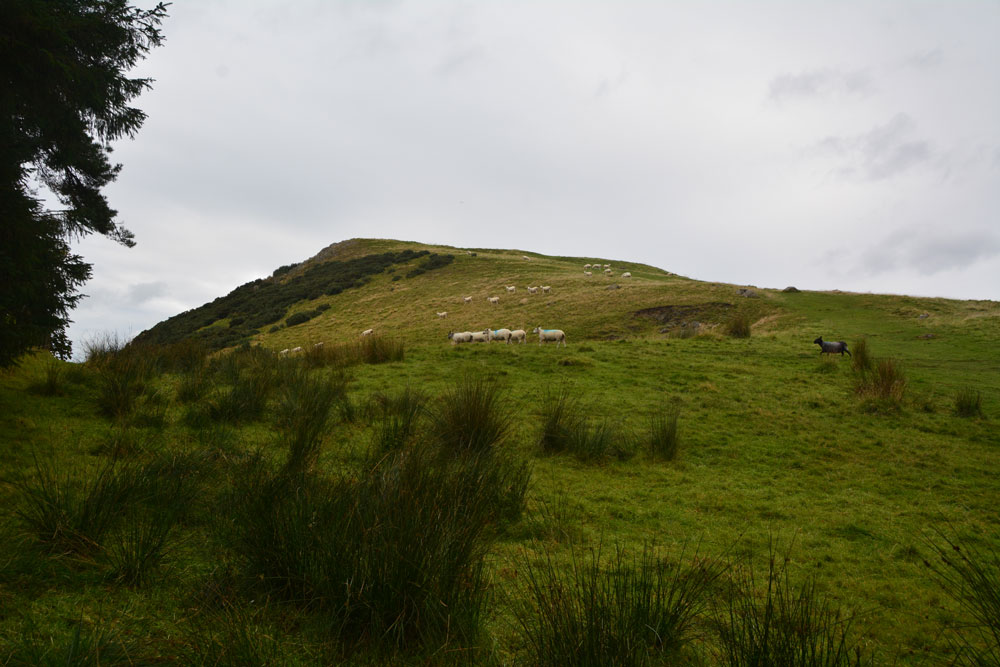
Cockleroy Hill (Beecraigs) submitted by Anne T on 5th Oct 2017. First view of Cockleroy Hillfort, having walked from the small car park to the gate into the field. The hill rises reasonably steeply up to 278 metres and has a trig point and view point on top.
(View photo, vote or add a comment)
Log Text: Cockleroy Hillfort, Beecraigs Country Park: From Lower Craigmailing Socketed Stone, we drove north past the Korean War Memorial to Beescraig Country Park. There was a small car park at about NS 99445 74270, where a path led through the forest, leading to a gate into the field containing the hillfort.
According to the Scotsman of 9th December 2012, Cocklroy means “the hat of the kings”. Situated in Beecraigs Country Park forest, there is a climb of 278 metres to the top and a mown path goes straight up the hill to the top of the fort, where there is a viewpoint. I wasn’t feeling too good, so opted out half way up the climb. Andrew continued up to the trig point at the top, and had great views across Lochcote Reservoir to the south west and the Forth Bridges at Queensferry to the north east.
Andrew said there wasn’t much to see of the fort itself – there were very little signs on the ground. I sat on the large stones about half way up the slope, at first thinking they were defensive ditches and banks, but were in fact modern quarries, when I looked closer!
Gormyre
Trip No.49 Entry No.4 Date Added: 6th Oct 2017
Site Type: Standing Stone (Menhir)
Country: Scotland (West Lothian)
Visited: Yes on 22nd Sep 2017. My rating: Condition 3 Ambience 4 Access 4

Gormyre submitted by Anne T on 23rd Mar 2019. Hi, AstroGeologist, With reference to your comment about the farmer having moved the stone, I don't think he has. Here's my version of your photo shown in PID 194979 with the same tree, albeit from a slightly different angle, taken on 22nd September 2017. The stone still sits on top of the distinct, flat-topped high point on the hill. The angle of the hedge line running across the photo is still the same. The stone was recorded by Canmore as being at this same location in 1856.
(View photo, vote or add a comment)
Log Text: Gormyre Stone, Torphichen: Ever since I went to Torphichen on 13th May 2017, I’ve wanted to come back and not only look round the Preceptory, but also try to find the other refuge stones associated with the Sanctuary Stone in the churchyard.
Today, despite not feeling 100% I was glad to be in search of this stone, and delighted to be able to see it from the road. We parked at NS 98072 72853 (there was just enough room by the gate to pull off the road), approximately 1.2 km east of Torphichen Preceptory.
The farmer had padlocked the gates into the field and the track which ran alongside it; these were really high and a little precarious to climb over (didn’t want to break them), so I ended up clambering gingerly over the wooden fence next to the gate. Following the grassy trackway north, just over 200 metres further on there was another gate, again padlocked, so we negotiated the wooden fence next to it. Thankfully, the huge bull and his ladies were in the adjoining field.
This stone sits on top of a natural mound. We couldn’t see the outline of the Maltese Cross on the north face of the stone, despite careful looking at a number of different angles and distances (although looking at one of the photographs, it does stand out a little). A really nice location, and a very friendly stone.
